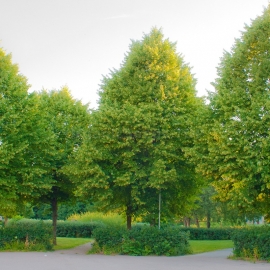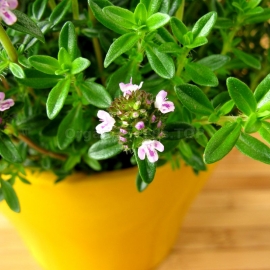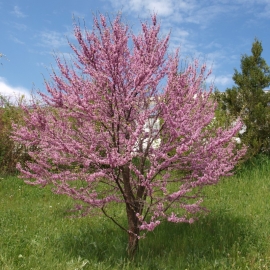




Organic Linden Seeds (Tilia cordata)
1.14 €
Deciduous tree 20-38 m tall with a tent-shaped crown, which has regular flowers, bisexual, with a double five-part perianth, up to 1-1.5 cm in diameter, yellowish-white, odorous, collected in drooping corymbose inflorescences.
-
Heart-shaped linden, or Small-leaved linden / Tilia cordata
A tree widespread in Europe and Western Asia; species of the genus Linden of the Malvov family; earlier, the genus Linden was usually separated into an independent family of Lindens (Tiliaceae).
Deciduous tree 20-38 meters tall with a tent-shaped crown. The bark is dark, furrowed on old trees. Leaves are alternate, cordate, long-petiolate, dentate, with a drawn pointed tip, green above, glaucous below.
The flowers are regular, bisexual, with a double five-part perianth, up to 1-1.5 centimeters in diameter, yellowish-white, odorous, collected in drooping corymbose inflorescences of 3-11 pieces, with inflorescences there is an oblong yellowish-green stipule. There are many stamens in the flower. Blooms from early July for 10-15 days. The nectar-bearing tissue located on the inside of the sepals' bases secretes 5-10 milligrams of nectar.
Pollen grains are three-furrowed, spherical-flattened in shape. The length of the polar axis is 25.5-28.9 microns, the equatorial diameter is 32.3-35.8 microns. Almost rounded in outline from the pole, elliptical from the equator. The grooves are slit-like, short, visible only under the immersion lens. Ores are longitudinally elongated, with uneven edges, deeply submerged, with a maximum diameter of 10.5-11 microns; the porous membrane is smooth or fine-grained. The width of the mesoporium is 23.5-28.1 microns. The thickness of the exine in the center of the mesoporium is 2.2 µm, about op 8 µm; the upper layer of exine, slightly wedging out, covers the scream. The rod layer has a thickness of 0.8-1 microns, the rods are straight or knotted, with rounded or flattened heads. The cells are angular or oval, formed as a result of the merging of the walls of the rods or their heads; the largest cell diameter is 1.2 µm, the smallest is 0.5 µm. The pollen color is light yellow-green.
The fruit is spherical, pubescent, thin-walled, one- or two-seeded nut. The fruits ripen in August - September.
The name can be pronounced as a sercelist linden, or a zvichyna linden, a common linden.
Growing linden cordata
Linden is one of the most flexible trees, capable of adapting to different living conditions (especially the small-leaved linden, widespread in the European part of Russia). It can exist both in the form of a large tree and in the form of a shrub (in conditions of oppression under the canopy of a forest). Linden is capable of vegetative propagation with the help of special underground shoots, due to which it "creeps" itself under the forest canopy. Within its natural range, it can grow in almost any soil conditions, although, of course, it prefers fertile and well-moistened soils. Growing large seedlings in a nursery takes one to two years.
The peculiarity of the cultivation of small-leaved linden and other types of lindens found in Russia is the absolute need for special pre-sowing seed treatment or autumn sowing. Without long (3–6 months, depending on the type of linden and the quality of the seeds) keeping the wet seeds at a temperature of about 0 °, the seeds simply do not germinate. In order to ensure the normal germination of seeds, you can either sow them in the fall (then the necessary cold preparation will take place naturally), or keep them under appropriate conditions - for example, in boxes with sawdust or wet sand placed in a cold basement.
If you have a glacier (a cellar in which a thick layer of ice freezes in winter and as a result the temperature remains close to 0 ° in summer), then the seeds can be stored in such a glacier before planting - again in boxes with sawdust or wet sand. After such preparation, the seeds can no longer be dried, otherwise they will die - they must immediately be sown into moist soil.
In general, linden is not the easiest tree to grow in amateur nurseries, although different types of linden are capricious to varying degrees. In addition to the need for pre-sowing preparation, linden is characterized by sensitivity to late spring frosts - seedlings that appeared before such frosts can easily die. Small linden seedlings are quite difficult to tolerate transplanting (one-year-old seedlings should be transplanted only in spring, autumn transplantation is much more difficult for them).
In addition to sowing seeds, you can use the transplantation of linden seedlings that appear under the crowns of old trees after a bountiful harvest of seeds. Linden seedlings have very characteristic lobed cotyledons, so they are easy to find. Small shoots (not yet having true leaves, but only cotyledons) easily tolerate transplanting if done in cool and humid weather. Under favorable conditions, "wild" seedlings can easily be dug into a whole garden bed. Since linden seeds germinate rather late and uncommonly, you should start looking for seedlings after the first leaves begin to bloom on adult lindens.
Sowing seeds should be done in rows at a distance of 15–20 centimeters from each other, sowing 100–300 seeds per 1 m of row length. Cover the grooves with sown linden seeds with a layer of soil 5-7 millimeters. Keep the soil moist; if it is not very wet to the touch, it is advisable to water the beds before sowing the seeds. Keep in mind that linden is vulnerable to late frosts, so it is very useful to cover crops (or plantings of "wild" seedlings) with a temporary greenhouse made of film or non-woven covering material, but in such a way as to maintain the ventilation of the greenhouse. After the threat of frost has passed, it is best to clean the greenhouse.
Linden, like elm, is very sensitive to soil moisture. Therefore, in dry weather, crops must be watered. In good conditions, the height of seedlings by autumn can reach 15-50 centimeters (depending on weather conditions, soil and linden species). In the spring of next year, the lindens must be transplanted into the "school" (the largest seedlings can be selected and transplanted to a permanent place). In the "school", rows of seedlings should be placed at a distance of 25-30 centimeters from each other, and seedlings within a row - at a distance of 5-10 centimeters. By the fall of the second year, the seedlings will reach the size at which they can be transplanted to a permanent place. Only in a cold and unfavorable year can the growth be too small. In this case, it is advisable to leave lindens in the "school" for one more year.
Products Viewed Before
Product code: 1487
1.14 €
This is a quite stunning Snapdragon. Growing up to 4 feet tall and with pure white flowers on strong stems, 'Admiral White' is a stately plant for your border and eye-catching in a vase.
Product code: 6756
1.14 €
Every herb garden needs Savory seeds! Grow Summer Savory for your garden from herb seeds and season meat and veggies all summer long. As fast as you pick these aromatic leaves, new ones begin to grow!
Product code: 13301
3.00 €
A highly branched tree or shrub with a wide crown, with reddish branches and heart-shaped, green leaves, at the time of flowering, completely refute the specific name of extraordinary bright beauty.
Product code: 15489
0.91 €
Mid-early variety, the growing season from germination to the start of fruiting is 50 days, the fruits are cylindrical, slightly tuberculate, 9-12 cm long, weighing 90-110 grams. Income for support Armed Forces of Ukraine.




